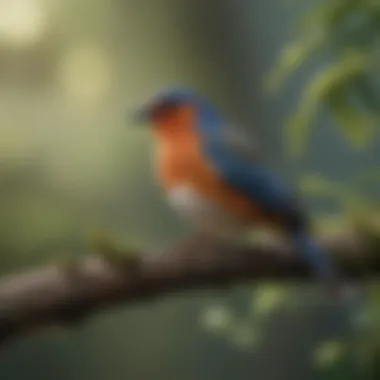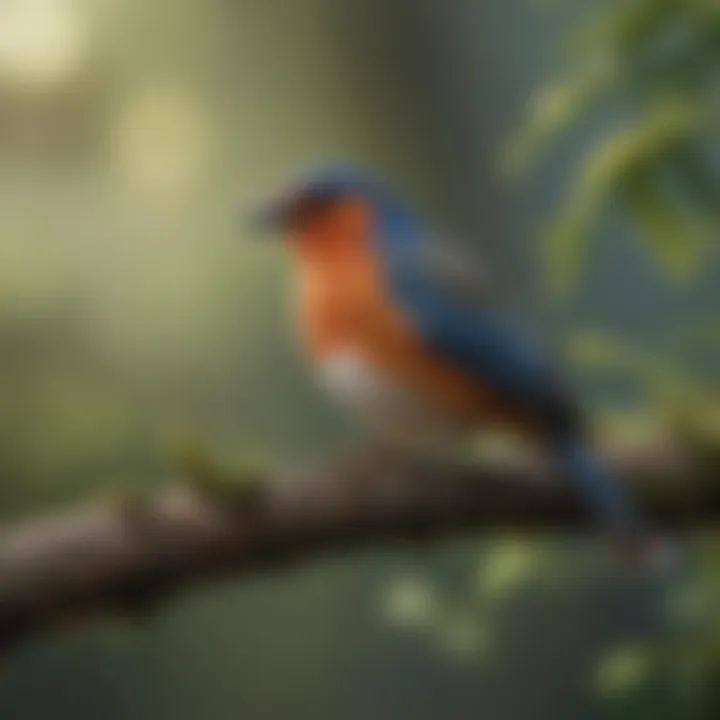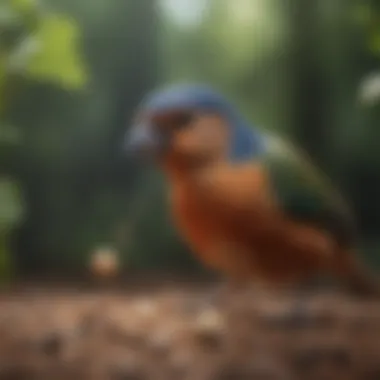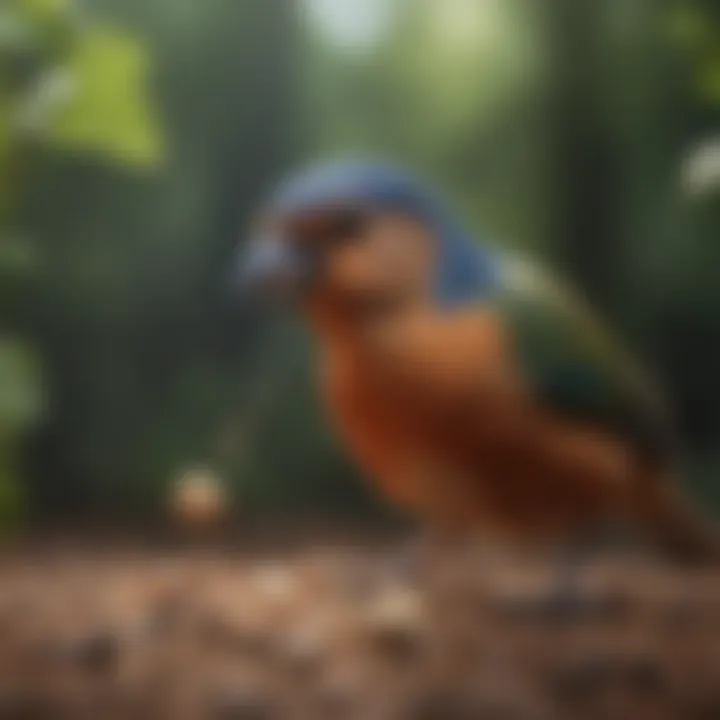Understanding Bird Lifespan: Key Factors for Longevity


Intro
Understanding the lifespan of birds requires an exploration of numerous factors that shape their longevity. This includes genetics, diet, environment, and various specific behaviors related to different species. For pet owners and bird enthusiasts, recognizing these aspects is crucial for enhancing the lives of these creatures and foster a deeper connection.
The following sections will dissect the essential elements influencing the life expectancy of birds, guiding caretakers to make informed decisions that can promote healthier, longer lives for both wild and domesticated species.
Understanding Your Pet
Learning about the species you care for is the first step in providing optimal care. Each bird species has unique traits, behaviors, and requirements. A comprehensive understanding goes beyond basic knowledge and delves into specifics.
Pet Behavior Basics
Birds exhibit a range of behaviors influenced by their species and personality. It is essential for owners to observe and understand these behaviors. For example, some species like parrots are more social, requiring interaction and stimulation, while other species may be more solitary. Recognizing stress signals or signs of illness in birds can lead to timely interventions, thereby enhancing their quality of life.
Common Breed Characteristics
Different species of birds vary greatly in size, temperament, and social needs. Larger birds, such as macaws or cockatoos, typically have longer lifespans compared to smaller species, like finches or canaries. Additionally, understanding these breed characteristics is important when selecting a pet bird. Each bird's lifespan can be influenced by factors such as their specific behavioral traits and social structure.
Species-Specific Needs
Each bird species has unique requirements regarding habitat, diet, and social interaction. For example, budgerigars need ample space to fly and engage with their owners, whereas canaries prefer a quieter environment. Providing tailored care not only enhances the bird's overall well-being but also supports optimal aging.
Pet Care and Maintenance
Proper care and maintenance are vital to ensuring longevity. Each component of care contributes to a bird's health and quality of life.
Feeding Guidelines
A balanced diet specific to the species is crucial for maintaining health. Birds generally require a mix of seeds, pellets, fruits, and vegetables to thrive. It is essential to research appropriate dietary needs, as deficiencies or inappropriate foods can lead to health issues.
Grooming Essentials
Regular grooming is part of maintaining a bird's health. Birds may need nail trimming, wing clipping, and feather care depending on their species. This not only aids in physical health but also supports a positive behavior pattern in birds.
Hygiene Practices
Maintaining clean habitats is fundamental. Regular cleaning of cages and providing fresh water can prevent the onset of diseases. Understanding the hygiene needs specific to each bird species is key to ensuring a healthy living environment.
Training and Development
Training serves as another pillar of longevity, benefiting both the bird and the owner. Establishing a routine contributes to the bird's mental stimulation and harmony in the household.
Basic Commands and Skills
Teaching basic commands can enhance communication between the owner and bird. Simple cues such as
Preamble to Bird Longevity
Understanding the lifespan of birds is crucial for both enthusiasts and casual observers alike. It goes beyond mere curiosity about how long these fascinating creatures can live. The lifespan of different bird species can greatly influence their behavior, breeding patterns, and overall management. For pet owners, knowing the expected lifespan of their birds can help in providing better care and health management.
The notion of longevity in birds prompts various considerations, particularly regarding their environmental needs, diet, and genetic factors. Each factor has a specific impact on the bird’s individual life expectancy. By exploring these elements, one can gain deeper insights that inform both research and caregiving practices.
The importance of evaluating bird longevity also extends to conservation efforts. Different species may face unique threats in the wild due to their lifespan, which can affect population dynamics. When we understand how long birds typically live, along with the challenges they encounter, we can better strategize conservation and protection initiatives.


In summary, bird longevity matters not just from an academic standpoint but also for practical applications in pet care and wildlife conservation. It is a multifaceted subject that warrants in-depth examination.
The Importance of Lifespan in Bird Species
The lifespan of bird species serves as a vital indicator of their overall health and resilience. Different species exhibit varying life expectancies, influenced by their genetics and ecological niches. Knowing these differences allows bird enthusiasts and pet owners to tailor their care and management approaches.
- Health Indicators: Lifespan can reveal the health status of a species. Shorter lifespans may indicate higher susceptibility to diseases or environmental stressors.
- Behavioral Insights: Understanding lifespan offers clues into breeding behaviors and migration patterns. For example, species with longer lifespans may invest more in raising offspring.
- Conservation Status: Species with shorter lifespans might be more vulnerable to extinction, especially if their reproduction rates cannot compensate for mortality.
- Economic Factors: For pet owners, knowing a bird's lifespan can influence purchasing decisions and ongoing care investments.
General Lifespan of Birds
Bird longevity is a crucial factor to be understood for anyone involved with avian species. It shapes the care strategies that pet owners and bird enthusiasts implement. By grasping the lifespan of various birds, one can better appreciate their needs through different life stages. This knowledge informs choices about diet, environment, and health care. Understanding bird lifespan also fosters a deeper connection with these remarkable creatures, enhancing overall enjoyment and appreciation.
Average Lifespan Across Species
The average lifespan of birds varies widely, influenced by their individual biology and environment. Generally, smaller species like the American finch tend to have shorter lives, averaging around 2 to 5 years. Larger species, including macaws or African grey parrots, can live much longer, often surpassing 50 years with proper care.
Some notable averages include:
- Canaries: 10 to 15 years
- Cockatiels: 15 to 20 years
- Budgerigars: 5 to 10 years
These differences affect how owners plan for their birds’ long-term care and life expectancy considerations.
Comparison of Lifespan in Different Bird Groups
Understanding the variations in lifespan among bird groups is essential. Birds can be categorized in numerous ways, including by size, habitat, or dietary preferences, and these categories often correlate with their longevity.
- Passerines (songbirds): Generally have shorter lifespans, averaging 2 to 5 years. Environmental challenges play a big role in these numbers.
- Raptors: Such as eagles and hawks, can live longer. Their lifespans can range from 15 to 25 years due to their position at the top of the food chain.
- Waterfowl: Many ducks and geese exhibit lifespans around 10 to 20 years, with variations based on species and predation.
Through these comparisons, owners can develop tailored care and management strategies that promote better wellbeing for their birds, enhancing their quality of life.
"Understanding the lifespan of birds is not just about numbers; it informs their care and enriches the bond we share with them."
Factors Influencing Bird Lifespan
Understanding the various factors influencing bird lifespan is crucial for both pet owners and enthusiasts interested in avian health. Lifespan is not just a number; it reflects the overall well-being, ecological adaptations, and evolutionary history of bird species. Knowledge of these factors can help individuals provide better care for their birds, ensuring they live longer, healthier lives. This section will examine the complexity of lifespan determinants, which include genetics, environment, diet, threats, and habitat. Each element contributes uniquely to the overall health profile of these creatures.
Genetic Factors
Genetics plays a significant role in dictating the lifespan of individual bird species. Certain genetic variations can predispose birds to specific health issues or longevity. For example, larger birds often exhibit longer lifespans. Studies indicate that some species of parrots can live over 50 years, while smaller birds such as finches generally have much shorter life expectancies. Genetic selection can also directly impact not just longevity but overall health traits, influencing resistance to diseases and the ability to adapt to environmental challenges. Breeders and pet owners must be aware of the genetic background of their birds, as this knowledge can guide care practices and health monitoring.
Environmental Factors
The environment where birds live can significantly affect their lifespan. Factors such as climate, habitat stability, and availability of resources are intertwined with the health and longevity of bird populations. For instance, birds that live in clean, protected habitats tend to enjoy longer lives compared to those exposed to pollution or habitat destruction. Seasonal changes can also result in stress that may shorten lifespans. For example, extreme weather events can impact food availability and nesting success. Conservation efforts aimed at maintaining suitable environments are vital for preserving various bird species and their longevity.
Dietary Considerations
Nutrition cannot be overlooked when discussing lifespan. A well-balanced diet tailored to the needs of specific bird species is integral to building resilience against diseases and promoting overall health. For instance, parrots require a diet rich in fruits, vegetables, and high-quality pellets to thrive. In contrast, seed-only diets are often insufficient and can lead to shortened lifespans. Obesity in birds is a growing concern, and it is linked to a range of health issues that ultimately affect longevity. Understanding the specific dietary needs of pet birds can empower owners to make informed choices that enhance their birds’ quality of life.
Predation and Threats
Predation represents one of the most significant threats to wild bird populations, with many species having developed various strategies to evade predators. However, predation is just part of a larger picture. Birds also face threats from habitat loss, human interference, and climate change. These additional stresses can shorten lifespans by causing health decline or reduced breeding success. For example, ground-nesting birds are particularly vulnerable to predators and environmental changes, impacting their survivorship rates. Raising awareness about these threats can promote conservation efforts aimed at protecting various bird species from external pressures.
Living Habitats
Lastly, the type of habitat that birds inhabit is critical to their survival and longevity. Birds adapted to specific environments often thrive best in those conditions. Forest-dwelling species, for instance, may depend profoundly on tree density and food availability. On the other hand, urban birds may develop different lifespans based on how they adapt to human landscapes. This relationship between species and habitat underlines the importance of preserving natural environments. Responsible habitat management and conservation practices can provide the stability that bird populations require for longer lifespans.


"Understanding the intricate factors influencing bird lifespans not only aids in conservation but also helps pet owners provide better care for their feathered companions."
Through thorough examination of these factors, we can better comprehend how to preserve bird species and enhance their lives and well-being.
Lifespan in Common Bird Species
Understanding the lifespan in common bird species is essential for anyone interested in avian care, whether for pet ownership or wildlife observation. This topic sheds light on how different environments, care practices, and species types influence longevity. Deep awareness of these differences can significantly impact how owners approach the care and management of their birds.
Bird species exhibit varying life expectancies based on their habitat and domestication. Recognizing these variations informs better care, encouraging owners to adapt their practices to best support their feathered companions.
Pet Birds
Pet birds, which people keep in homes, vary widely in lifespan depending on their species. For example, budgerigars can live around 5 to 10 years, while African grey parrots may live 30 years or more with proper care. Pet birds often benefit from regular veterinary check-ups, a balanced diet, and social interaction, which can enhance their quality of life and longevity.
Factors contributing to the lifespan of pet birds include:
- Diet: A well-rounded diet ensures that birds receive essential nutrients. Pellets, seeds, fresh vegetables and occasional fruits can promote health.
- Housing: A safe and spacious cage allows birds to exercise and display natural behaviors.
- Socialization: Birds are social animals that thrive on interaction. Engaging with them regularly can alleviate stress and improve their mental health.
- Health Care: Preventive care from avian veterinarians can help identify issues early, contributing to a longer lifespan.
In summary, pet birds require attentive care and understanding to maximize their longevity and well-being.
Wild Birds
Wild birds face numerous challenges that can affect their lifespan. Overall, wild birds tend to have shorter lifespans than domestic ones, primarily due to environmental factors. For instance, species like the American robin live about 2 years on average, but some may reach 14 years under ideal circumstances. In contrast, larger wild birds, such as bald eagles, can live up to 30 years in the wild.
Key elements influencing the lifespan of wild birds are:
- Habitat: Availability of food and appropriate shelter in their environment can significantly alter their survival rates.
- Predation: Natural enemies pose constant threats, which can shorten life expectancy.
- Climate Change: Alterations in weather patterns can affect food sources and nesting sites, impacting longevity.
- Human Impact: Urbanization and habitat destruction have complicated nesting and feeding opportunities for many species.
Wild birds must constantly adapt to survive, balancing the challenges presented by nature and human activity. Understanding these factors enriches our appreciation for avian life and informs conservation efforts aimed at helping wild populations thrive.
Case Studies of Individual Bird Species
Case studies are essential in understanding the varied lifespans of different bird species. They offer insights into how specific factors like genetics, environment, and care affect longevity. Analyzing individual birds allows for an exploration of unique traits and practices that can influence their life expectancy. This not only helps bird owners make informed decisions about care but also aids researchers in identifying trends across species, ultimately enriching our collective knowledge of avian biology.
Parrots: Lifespan and Care Requirements
Parrots are known for their remarkable lifespans, often living between 20 to 80 years depending on the species. Their captivating colors and intelligence make them popular pets. However, caring for a parrot requires dedication and understanding of their unique needs. Diet plays a crucial role in their health and longevity. A balanced diet rich in fruits, vegetables, and high-quality pellets is essential. Regular social interaction and mental stimulation can prevent behavioral issues that shorten their lives. Additionally, providing an enriching environment with toys and opportunities for exercise is important for their well-being. Proper veterinary care, including routine check-ups, can catch health issues early, further extending their lifespan.
Canaries: Understanding Their Lifespan
Canaries are small birds known for their melodic songs and vibrant colors. Their average lifespan ranges from 5 to 10 years, but with proper care, some can live longer. A key factor in their longevity is a well-balanced diet. Seed mixtures supplemented with fresh greens and proper vitamins can enhance their health. Stress management is also vital, as canaries are sensitive to changes in their environment. A quiet and safe living space reduces anxiety and its negative health impacts. Regular health evaluations can identify potential issues before they become serious. Understanding these aspects helps canary owners provide better care, thereby promoting longer lives for their feathered companions.
Songbirds: Lifespan in the Wild
Songbirds, which encompass various species, exhibit diverse lifespans in the wild. Factors such as habitat, predation, and food sources greatly affect their survival. While some songbirds may only live for a couple of years, others have life expectancies exceeding 10 years. Their ability to find adequate food and avoid danger from predators is crucial. Nesting success also plays a part; songbirds that can successfully rear their young contribute to longer generational lifespans. Migration patterns impact their life expectancy as well, with some species facing threats during long journeys. Studying the lifespans of songbirds in their natural habitats provides valuable information about the ecological balance and conservation efforts needed to protect these vital species.
The Role of Veterinary Care
Veterinary care plays a crucial role in enhancing the lifespan and overall health of birds. Unlike many pets, birds may often exhibit subtle signs of illness, making regular veterinary attention important. This not only helps in early detection of health issues but also provides an opportunity for birds to receive essential preventive care. Various aspects of this care can significantly influence a bird's longevity and quality of life.
Regular interactions with a veterinarian can help in monitoring a bird's health status. By establishing a good relationship with an avian veterinarian, owners can gain insights into their pet's specific health requirements. Such diligence can prevent common health problems that may shorten a bird’s lifespan, such as nutritional deficiencies or diseases.
Preventive Health Care for Birds
Preventive health care for birds includes a variety of practices designed to maintain and improve their health. This starts with selecting a proper diet suited to the specific species of the bird. A vet can advise on the necessary nutritional components, including vitamins and minerals that are vital for bird health.


Benefits of preventive health care:
- Early Detection: Regular check-ups allow for the early detection of potential health issues.
- Vaccinations: Birds can be vaccinated against common avian diseases, which is an essential preventive step.
- Behavioral Screening: A vet can also assess behaviors that indicate environmental stress or illness.
In addition, proper hygiene and environmental cleanliness can also be promoted through veterinary advice. Keeping a bird's habitat clean reduces the risk of infections and other health problems.
Importance of Regular Check-Ups
Regular check-ups are fundamental for sustaining a bird's health over the years. These visits should ideally occur at least once a year, or more frequently for older birds or those with known health concerns.
It is essential to prioritize the health of birds through consistent veterinary visits, as these can significantly impact their lifespan.
During a typical check-up, a veterinarian will conduct a thorough examination to assess the bird's overall health. This can include:
- Weight Measurement: Monitoring weight helps detect changes that might indicate health issues.
- Feather and Skin Examination: Inspecting feathers can reveal conditions like mites or infections.
- Beak and Claw Health: Ensuring these remain in good condition is vital since they affect feeding and mobility.
Moreover, regular assessments can help the veterinarian educate the owner on aspects of care, enhancing knowledge about behavioral and physical changes an owner may not notice. Through this, owners become more adept at managing their bird’s health, which ultimately supports a longer and healthier life for their cherished companions.
Caring for Aging Birds
Caring for aging birds is an essential aspect of avian ownership that can greatly impact a bird's quality of life and longevity. As birds age, their physical and emotional needs evolve. Understanding these needs is crucial for pet owners seeking to provide the best possible environment for their feathered companions. Notably, birds experience changes in health, energy levels, and behavior as they grow older. Thus, recognizing these changes fosters a better understanding of their care requirements.
Adapting Diets for Older Birds
Diet plays a significant role in the health of aging birds. As birds age, their metabolic processes can slow down, and their nutritional needs may change. They may require fewer calories, yet still need a balanced diet rich in essential nutrients. Pet owners should consider the following when adjusting their birds' diets:
- High-quality pellets: These provide essential vitamins and minerals. Brands like Hagen and Kaytee produce specially formulated pellets for older birds.
- Fresh fruits and vegetables: Incorporating safe, fresh produce can enhance the nutrient profile of their diet.
- Hydration: Keeping drinking water fresh and accessible is crucial. Older birds may drink less but need adequate fluid intake.
- Supplements: Discuss with a veterinarian about specific supplements that might be beneficial, such as calcium or omega-3 fatty acids.
Regularly monitoring weight and overall health can help in making necessary dietary adjustments.
Creating a Comfortable Environment
The environment in which aging birds live should be tailored to their physical capabilities and comfort. As birds age, they may experience mobility issues and sensitivity to temperature changes. Here are some points to consider:
- Perches: Provide a variety of perches made of different materials to promote foot health. Wider perches can offer more stability for birds with arthritis or weak feet.
- Nest boxes: If the bird is a breeding species, a well-placed nest box can create a secure space for resting.
- Temperature Control: Maintaining a comfortable temperature range is essential. Older birds may require warmer environments, particularly during colder months.
- Quiet Spaces: Noise can stress aged birds. Creating quiet areas can reduce stress and give them a sanctuary.
Creating a supportive environment can lead to improved wellbeing and a more enriched life for aging birds. Caring for aging birds is a rewarding journey that reflects the bond between pet and owner. By adapting diets and environments, opposite improving care can be achieved.
Regular check-ups with a veterinarian can help in identifying age-related health issues early on, contributing to a longer and healthier life for your bird.
Closure: Understanding Bird Lifespan for Better Care
Understanding the lifespan of birds is not just an academic exercise; it has real implications for how we care for these creatures, both in captivity and in the wild. Knowledge of avian longevity helps bird owners and enthusiasts create better living conditions for their feathered companions, ensuring they can enjoy their lives to the fullest.
The insights drawn from studying bird lifespans reveal that various factors such as genetics, diet, and environmental conditions play significant roles in determining how long a bird may live. This information empowers owners to take proactive measures that can improve the quality of life for their birds.
The growing awareness of the needs of aging birds is particularly crucial. As they age, their requirements change. Providing an adapted diet and a comfortable environment can contribute significantly to their wellbeing. Moreover, understanding the lifespan trends among different species facilitates informed decisions about bird selection and care practices, ultimately leading to better outcomes for pet birds.
By grasping the factors that influence bird longevity, owners can make choices that contribute positively to their birds’ lives, whether they are domestic or wild.
Summarizing Key Points
Throughout this article, we explored several key elements regarding bird longevity. These include:
- Variability Among Species: Lifespan varies significantly across different bird species. Some species, like parrots, can live for multiple decades, while others, like some small songbirds, may only live for a few years.
- Genetic and Environmental Influences: Genetic elements in a bird can determine its potential lifespan. However, environmental factors such as habitat quality and predation risks also play a crucial role.
- Diet Importance: A well-balanced diet tailored to specific needs can greatly boost a bird's health and, thus, its lifespan.
- Veterinary Care: Routine health checks and preventive measures contribute to early detection of illnesses, which can extend the life of a bird.
- Adapting Care for Aging Birds: Adjusting care practices as birds age enhances their comfort and longevity.
Implications for Bird Owners and Enthusiasts
The implications of understanding bird lifespan extend well beyond just knowledge. For bird owners, this awareness can lead to:
- Informed Choices: When selecting a species, owners can consider longevity and care needs, ensuring they choose a bird that fits their lifestyle and commitment level.
- Enhanced Care Practices: By knowing the specific needs as birds age, owners can adapt their care strategies effectively. This includes dietary changes, enclosure modifications, and regular medical check-ups.
- Promoting Conservation Efforts: Recognizing the threats to wild populations and the factors influencing their lifespans encourages support for conservation initiatives.







